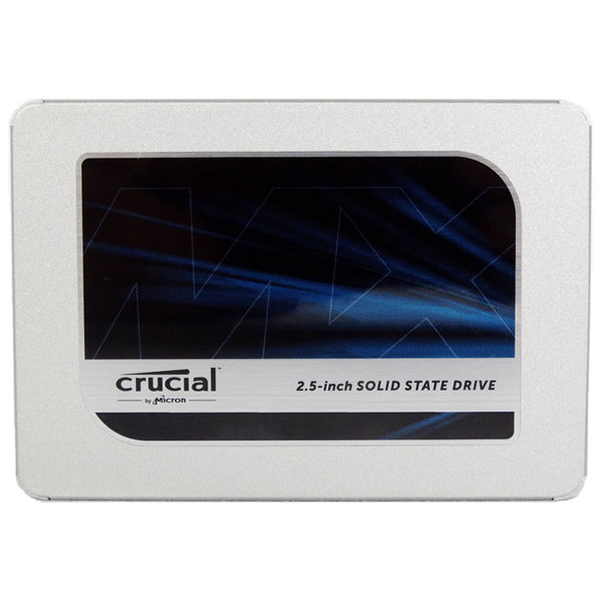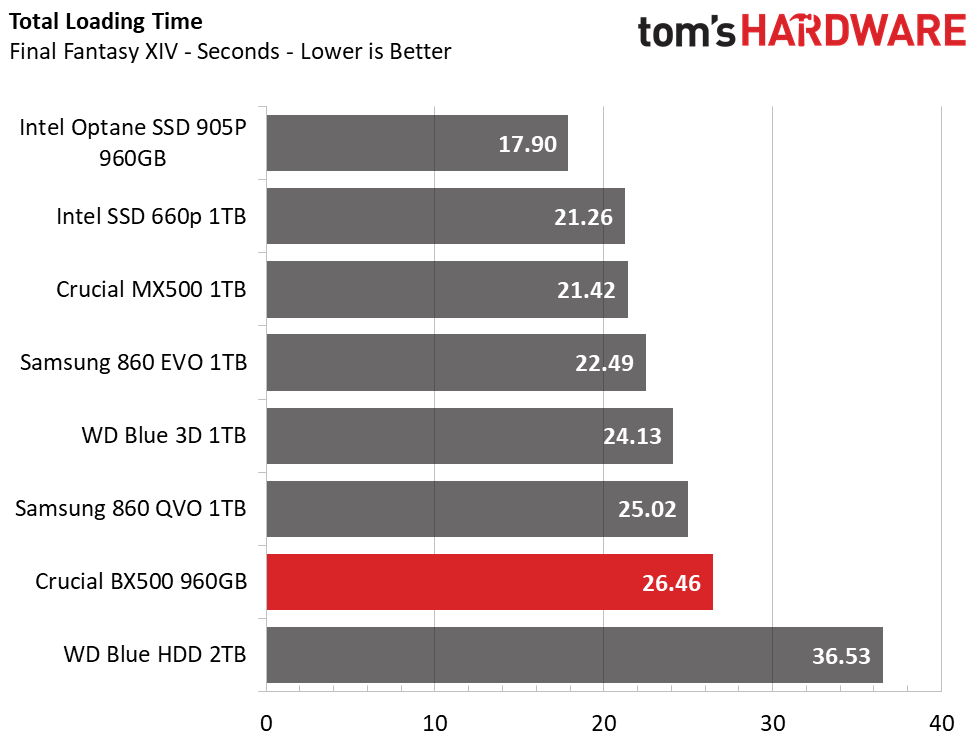Crucial BX500 SSD Review: The DRAMless Invasion Continues (Updated)
Why you can trust Tom's Hardware
960GB Comparison Products
We have added a few mainstream options to our comparisons for our 960GB BX500 testing. These include Crucial’s own MX500, Samsung’s 860 QVO and EVO, as well as WD’s Blue 3D and Intel’s SSD 660p. We have also added results from a 960GB Intel Optane SSD 905P and a 2TB WD Blue HDD for reference in a few of the real-world workloads.
Trace Testing – PCMark 8 Storage Test 2.0
PCMark 8 is a trace-based benchmark that uses Microsoft Office, Adobe Creative Suite, World of Warcraft, and Battlefield 3 to measure the performance of storage devices in real-world scenarios.


Crucial’s 960GB BX500 scores a total of 4580 points and an average bandwidth of 157 MB/s. This ranks as one of the lowest-performing SSDs we've tested and lands in last place. While it will be suitable for light workloads, it can’t keep up with the rest of the mainstream options under slightly tougher conditions.
Game Scene Loading - Final Fantasy XIV
The Final Fantasy XIV StormBlood benchmark is a free real-world game benchmark that easily and accurately compares game load times without the inaccuracy of using a stopwatch.
Loading Final Fantasy’s game scenes proved to be a task for the BX500. While it features similar read performance as the other drives, the BX500 was 2-5 seconds slower. Performance is still much better than any HDD, however.
Transfer Rates – DiskBench
We use the DiskBench storage benchmarking tool to test file transfer performance with our own custom 50GB block of data. Our data set includes 31,227 files of various types, like pictures, PDFs, and videos. We copy the files to a new folder and then follow up with a read test of a newly-written 6 GB file.


Crucial’s 960GB BX500 provided great read performance during our real-world copy test. It read our 6GB test file at an average rate of 494MB/s, which is in line with most other SATA SSDs.
Get Tom's Hardware's best news and in-depth reviews, straight to your inbox.
The BX500 fell on its face during our 50GB file transfer. With an average of 49 MB/s, the BX500’s copy performance proves to be rather pitiful, at best.
SYSmark 2014 SE
Like PCMark, SYSmark uses real applications to measure system performance. SYSmark takes things much further, however. It utilizes fourteen different applications to run real workloads with real data sets to measure how overall system performance impacts the user experience. BAPCo's SYSmark 2014 SE installs a full suite of applications for its tests, which includes Microsoft Office, Google Chrome, Corel WinZip, several Adobe software applications, and GIMP. That also makes it a great test to measure the amount of time it takes to install widely-used programs after you install a fresh operating system.


Just as we have seen during previous tests, the larger BX500’s performance isn’t much different during SYSmark. The 960GB BX500 installed SYSmark faster than an HDD by about 30 seconds, but other SSDs accomplished the task 3-4 minutes faster overall. The drive notched a responsiveness score of 1552 points, which nearly matches the Samsung 860 EVO and surprisingly surpasses the Samsung 860 QVO.
ATTO
ATTO is a simple and free application that SSD vendors commonly use to assign sequential performance specifications to their products. It also gives us insight into how the device handles different file sizes.


The BX500's performance in ATTO is similar to other SATA SSDs. Here the BX500 matched its ratings of 540/500 MB/s of read/write throughput. However, we see there is a dip in write performance that spans the 128KB-512KB file sizes. This is due to the DRAM-less architecture, which causes the BX500 to “get into a condition or state where background garbage collection briefly has to take precedence over I/Os” during the test.
Anvil's Storage Utilities
Anvil's Storage Utility is a commonly-referenced benchmark that simplifies the complex IOMETER benchmark and its underlying Dynamo engine with a one-click software wrapper.
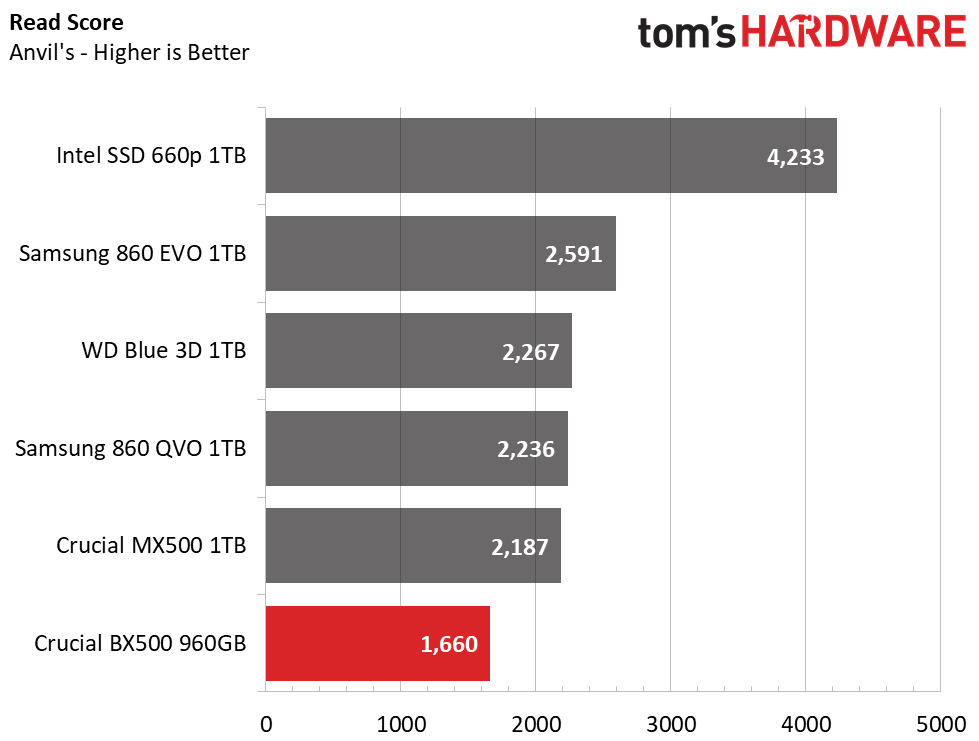

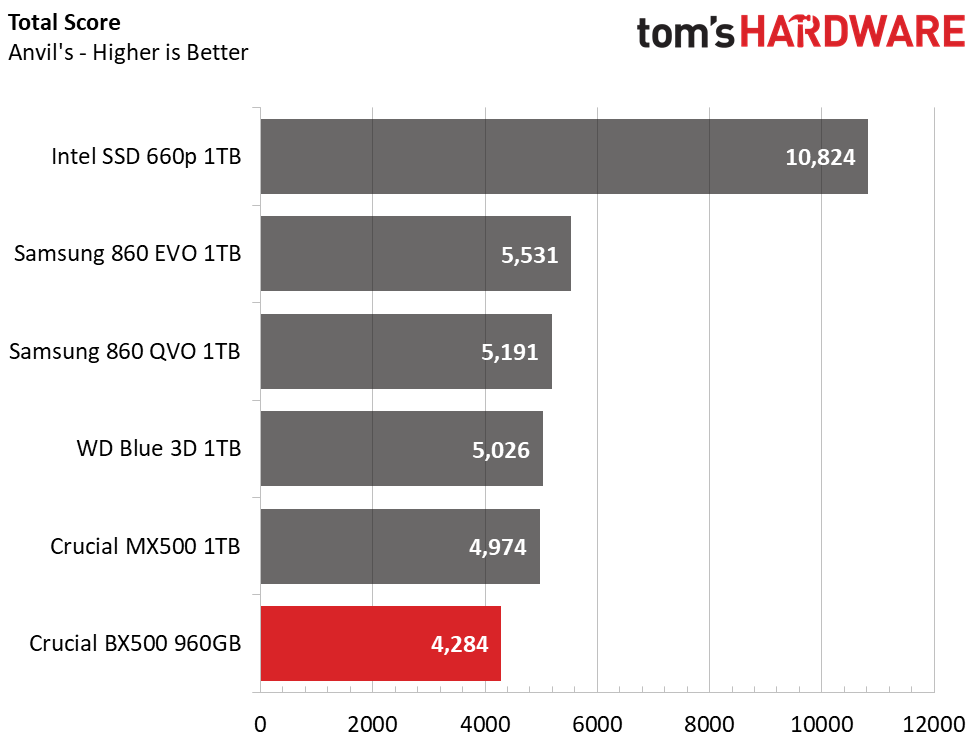
Crucial’s 960GB BX500 delivered low scores across the board in the Anvil benchmark. It achieved a total score of 4,282 points, which ranks in last place.
CrystalDiskMark
CrystalDiskMark (CDM) is a simple and easy to use file size benchmarking tool.




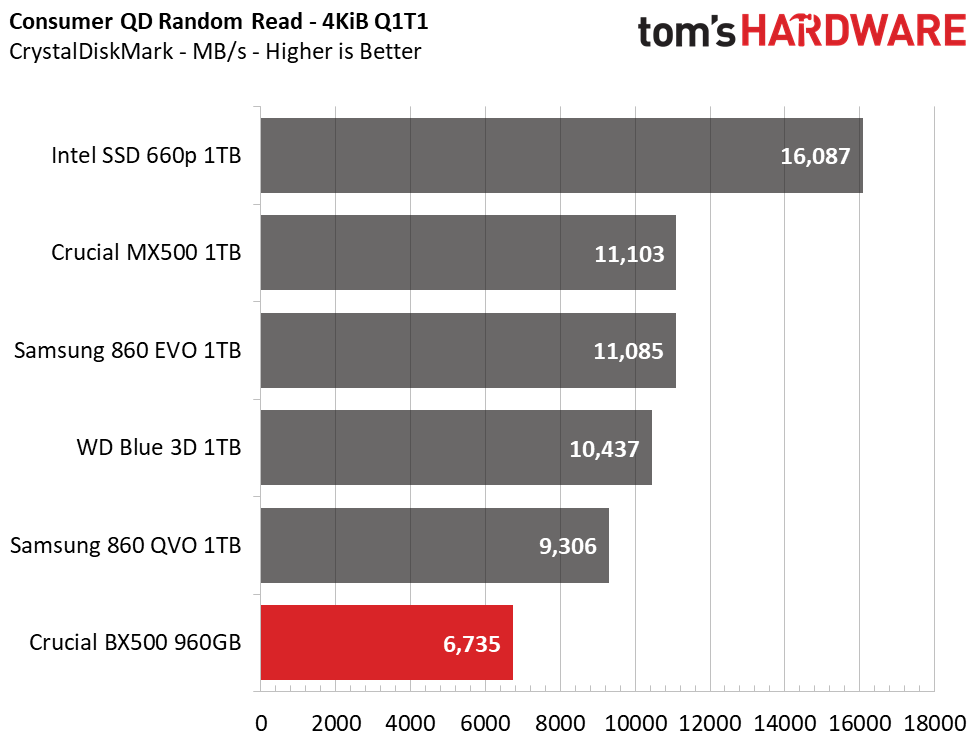




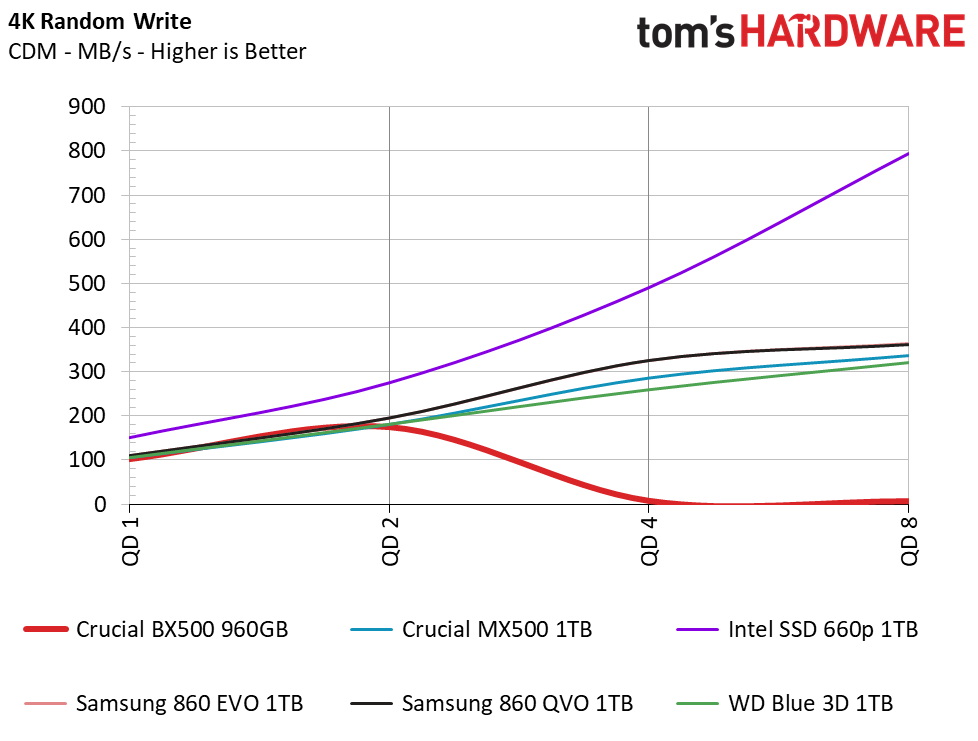
Crucial’s 960GB BX500 reached 562/337 MB/s of write performance at a queue depth (QD) of 32. At a QD of 1, it reached 504/442 MB/s of read/write throughput. Looking at random performance, the BX500 scored the lowest read and write scores. During heavier random access it hit just over 50,000 read IOPS, and a pitiful 1,875 write IOPS.
This goes to show that the BX500, again, hit a situation where background activity took precedence over delivering the IOs the host requested.
Sustained Sequential Write Performance
Official write specifications are only part of the performance picture. Most SSD makers implement an SLC cache buffer, which is a fast area of SLC-programmed flash that absorbs incoming data. Sustained write speeds can suffer tremendously once the workload spills outside of the SLC cache and into the "native" TLC or QLC flash. We hammer the SSDs with sequential writes for 15 minutes to measure both the size of the SLC buffer and performance after the buffer is saturated.



As expected, the 960GB BX500 uses an SLC cache for burst write performance of up to its 500 MB/s rating. After 48GB of data written, performance degrades to a write speed of 85MB/s. While this allows it to keep up with our comparison pool for the initial burst, most other SSDs will easily surpass its performance during long sustained write workloads.
Power Consumption
We use the Quarch HD Programmable Power Module to gain a deeper understanding of power characteristics. Idle power consumption is a very important aspect to consider, especially if you're looking for a new drive for your laptop. Some SSDs can consume watts of power at idle while better-suited ones sip just milliwatts. Average workload power consumption and max consumption are two other aspects of power consumption, but performance-per-watt is more important. A drive might consume more power during any given workload, but accomplishing a task faster allows the drive to drop into an idle state faster, which ultimately saves power.
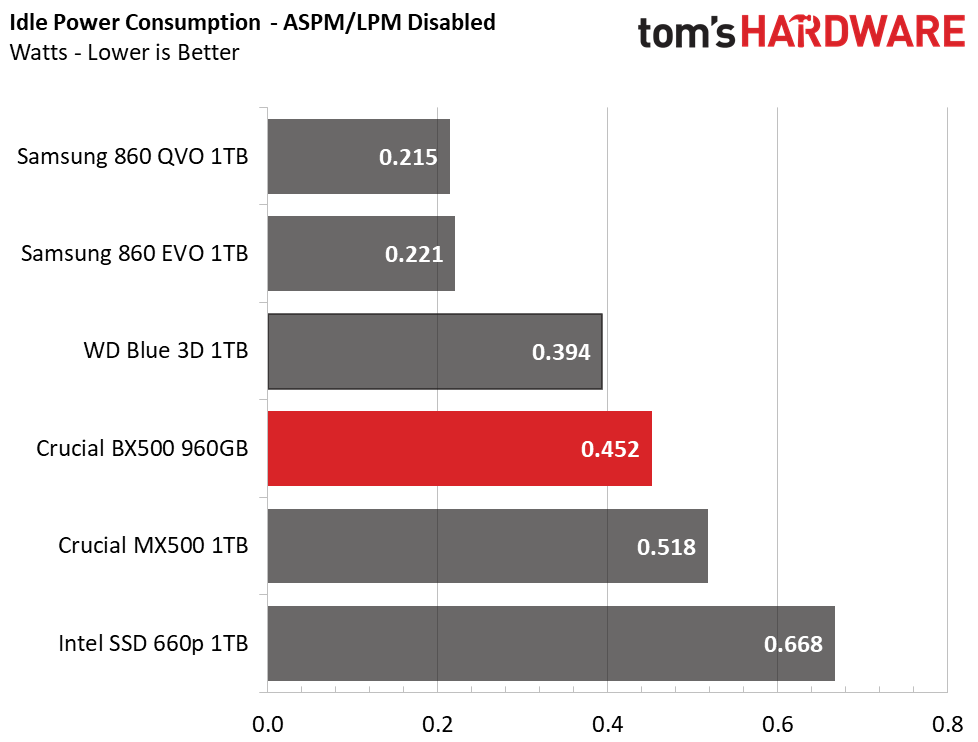

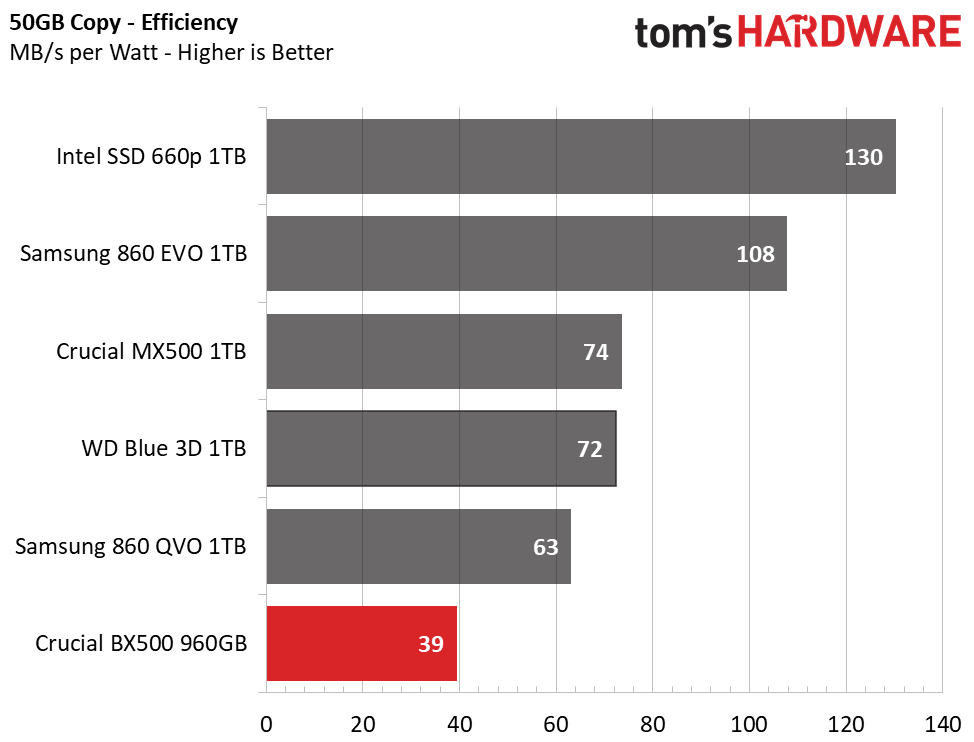


At idle the BX500 consumes fairly low power. Without LPM enabled, it consumes just under half a watt. With it enabled, it sips just 0.028W.
The drive consumes the least amount of power in our comparison pool under load, and the maximum power draw is similar to the Samsung 860 EVO. But, while it consumes the least amount of power, the slow transfer speed of 49 MB/s during the 50GB copy test leads to an average of just 39 MB/s per watt. The DRAM-less architecture lands it in the last place for efficiency.
MORE: Best SSDs
MORE: How We Test HDDs And SSDs
MORE: All SSD Content

Sean is a Contributing Editor at Tom’s Hardware US, covering storage hardware.
-
logainofhades Doesn't appear to be a great alternative to other drives already on the market. I'd rather spend the extra on an MX500 for the better warranty alone. I use a 1tb MX500, for extra storage, in my laptop. If you can use M.2 NVME, and are on a tight budget, though, the 660p is kind of a no brainer. I have had no complaints, with system performance, with the 1tb, that I have in my desktop.Reply -
chickenballs are you serious? they want 60 bucks for a 500gb dramless ssd?Reply
I just bought a MX500 500gb for 65 dollars...
125 dollars for a 980gb is also laughable when you can get the mx500 1tb for around 140 -
Glock24 Remind me why do DRAMless SSDs exists? You get lower performance, lower endurance and are almost the same price as decent SSDs. I don't see any benefit.Reply -
BaRoMeTrIc Reply
especially when the mx500 is only $5 more on amazon and newegglogainofhades said:Doesn't appear to be a great alternative to other drives already on the market. I'd rather spend the extra on an MX500 for the better warranty alone. I use a 1tb MX500, for extra storage, in my laptop. If you can use M.2 NVME, and are on a tight budget, though, the 660p is kind of a no brainer. I have had no complaints, with system performance, with the 1tb, that I have in my desktop. -
LordConrad Reply
Because there was a bigger price difference when DRAM was expensive.Glock24 said:Remind me why do DRAMless SSDs exists? You get lower performance, lower endurance and are almost the same price as decent SSDs. I don't see any benefit. -
chickenballs lol this is what I call ironyReply
https://www.tomshardware.com/news/crucial-mx500-500gb-ssd-deal-sale,39672.html -
dhivakarag Hi, I am confused between Crucial BX500 960GB (₹6770) vs Intel 660P 1TB (₹9500) as my gaming drive. I use Samsung 970 evo 500GB as my boot drive and I have installed all applications in it except games. Will my game load time decrease if I consider Intel over Crucial? Is Intel worth the price difference and is it reliable as Crucial?Reply -
MoisesLevy75 On the crucial website they report that the SSD has SLC write acceleration. This led us to think that he had NAND SLC memories when he actually has TLC. They has no respect the consumer.Reply
Moises Levy from Osório/RS - Brazil.


